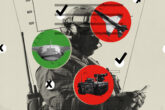June 15, 2022
Dangerous Straits: Wargaming a Future Conflict over Taiwan
Download the full PDF
Executive Summary
Until recently, U.S. policymakers and subject matter experts have viewed the People’s Republic of China’s (PRC’s) forcible unification with Taiwan as a distant threat. But the mix of rapid Chinese military modernization, a narrow window for localized near-parity with the U.S. military, and growing pessimism about the prospects for peaceful unification may lead the PRC to perceive that it has the ability to pursue a successful operation against Taiwan. Beijing’s lessons learned from Russia’s invasion of Ukraine could prompt the People’s Liberation Army (PLA) to adjust its war plans for Taiwan to become more effective and deadly. Coupled together, these developments may suggest an accelerated timeline for seizing Taiwan. It is therefore urgent that the United States, in conjunction with its regional allies and partners, identify ways to deter the PRC from invading Taiwan and prevent a future conflict.
To do so, the Gaming Lab at CNAS, in partnership with NBC’s Meet the Press, conducted a high-level strategic-operational wargame exploring a fictional war over Taiwan, set in 2027. The wargame sought to illuminate the dilemmas that U.S. and Chinese policymakers might face in such a conflict, along with the strategies they might adopt to achieve their overarching objectives. The game was intended to produce insights as to how the United States and its allies and partners could deter the PRC from invading Taiwan and could better position themselves to defend Taiwan and defeat such aggression should deterrence fail.
The wargame indicated there is no quick victory for either side if China decides to invade Taiwan. Neither side felt as though it had lost the fight over Taiwan, and even though China hoped to achieve a swift and decisive victory, it was prepared for a long fight. Beijing was faced with a dilemma: whether to keep the war limited and hope the United States did not become involved, or to preemptively strike U.S. targets to improve Chinese probability of success, but at the high cost of prolonging the conflict. In such a scenario, neither Beijing nor Washington is likely to have the upper hand after the first week of the conflict, which suggests a protracted conflict.
Moreover, a conflict over Taiwan may quickly lead to consequences far beyond what Beijing and Washington intend. The wargame demonstrated how quickly a conflict could escalate, with both China and the United States crossing red lines. There is a high risk that deterrent signals may be misread in a potential future fight due to differences in military strengths and weaknesses, and these shape the types of escalation Beijing and Washington are likely to select. As the wargame illustrated, despite its declared policy of no first use, China may be willing to brandish nuclear weapons or conduct a limited demonstration of its nuclear capability in an effort to prevent or end U.S. involvement in a conflict with Taiwan.
A conflict over Taiwan may quickly lead to consequences far beyond what Beijing and Washington intend. The wargame demonstrated how quickly a conflict could escalate, with both China and the United States crossing red lines.
The wargame highlighted an additional asymmetry in this tension: the role that capable U.S. allies and partners could play in a future conflict. Not only does China lack such relationships, but capable military partners on the U.S. side add significant combat power, depth, and strategic significance to efforts to defend Taiwan. This further complicates PRC decision-making about how it to may choose to invade Taiwan, and about how it may seek to deter U.S. and allied involvement.
Ultimately, the wargame indicates that the United States and its allies and partners have an opportunity to take steps to significantly strengthen deterrence and ensure that the PRC never sees an invasion of Taiwan as a profitable option. But, in order to change the Indo-Pacific military balance in their favor and develop the advancements in capability, posture, and planning that can hold PRC aggression at bay, the United States and its allies and partners must take immediate steps in several key areas.
First, the U.S. Department of Defense should make sustained investments in long-range precision-guided weapons and undersea capabilities, while also developing additional basing access in the Indo-Pacific region to facilitate operations and enhance survivability. The DoD should deepen its strategic and operational planning with highly capable allies such as Japan and Australia to improve their collective ability to respond to Chinese aggression against Taiwan. Additionally, DoD planning should move beyond defeating a rapid invasion to consider how to fight a protracted war and make changes to facilitate long-term operations and favorable war termination. Finally, the department ought to explore the risks of escalation in the context of a war with China, so that these can be anticipated, prevented, and managed.
Second, the U.S. Congress should enable key improvements through the Pacific Deterrence Initiative and should help shape Taiwan’s military posture. Third, Taiwan must improve its defensive capabilities by investing in asymmetric, resilient, and attritable capabilities by increasing training for its active and reserve forces; and by stockpiling key weapons and supplies.
Download the full PDF
More from CNAS
-
From Production Lines to Front Lines
Executive Summary The U.S. defense industrial base (DIB) is struggling to meet the demands of the current strategic environment—let alone prepare for a potential conflict agai...
By Becca Wasser & Philip Sheers
-
Safe and Effective
The promise of artificial intelligence (AI) and autonomy to change the character of war inches closer to reality...
By Josh Wallin
-
America’s Eroding Airpower
To have a chance at success, the United States would need more low-end drones and missiles that can provide it with mass....
By Stacie Pettyjohn
-
Build Allied AI or Risk Fighting Alone
Amid the hype about artificial intelligence (AI) and autonomous systems, militaries around the world are developing, experimenting with, and integrating these tools into every...
By Becca Wasser & Josh Wallin







